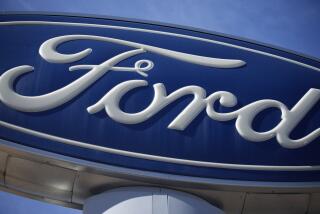Ford Works to Come Up With a Better Idea
- Share via
Its market share keeps shrinking, its product lineup is not enchanting customers, it loses money on every car and truck it sells in the U.S. -- and it isn’t General Motors Corp.
It’s Ford Motor Co., America’s No. 2 automaker, and though it isn’t in the red like industry giant GM, Ford is in the same leaky boat, wrestling for a life jacket.
On Monday, two months after an ailing GM rocked the industry with a plan to close a dozen factories and slash 30,000 jobs from its payroll, Ford plans to follow suit.
The company that made America and automobiles synonymous is expected to say that it too will shutter a dozen or more assembly plants and other facilities and eliminate 20,000 to 30,000 salaried and hourly jobs in North America, or as much as 25% of its total employment in the U.S., Canada and Mexico. In doing it, it hopes to slow its decades-long sales slide and regain control over spiraling costs and excess production capacity.
Mark Fields, Ford’s executive vice president and head of its North and South American operations, has the task of selling his restructuring plan to audiences with often competing objectives: a unionized workforce that is reluctant to give up benefits, and investors who have seen Ford’s stock fall 49% in the last two years. Ultimately, the company must win back car buyers who have flocked to other brands in such numbers that Ford sold 1 million fewer vehicles last year than it did in 2000.
Fields, at 44 a veteran of Ford operations on four continents, has already acknowledged what was once unutterable: The glory days of the Big Three automakers can’t be recaptured.
The new math in Detroit envisions a Big Six or Seven in a market that is “up for grabs,” Fields said in an interview.
Ford, GM and Chrysler Group, the American half of DaimlerChrysler, will continue to shrink. They will have to cede even more of the domestic market to the likes of Toyota Motor Corp., Honda Motor Co., Nissan Motor Co. and Hyundai Motor Co., Fields said.
Illustrating the point: As Ford’s U.S. market share has shrunk to 17.4% from 25% in 1995, Japanese juggernaut Toyota has grown to a 13.3% share from about 8%.
“We underestimated the competition” and ignored customers, said Fields, who was chosen late last year by Chairman William Clay Ford Jr. to draft the company’s resurrection plan, its second in four years.
“Now it’s change or die,” Fields said.
Although details of the plan, dubbed “Way Forward,” remain under wraps, Fields said a major component would be new products.
Ford certainly needs some: Its annual U.S. sales have dropped 30% to 2.9 million cars and trucks last year from 4 million in 2000. The Ford brand was surpassed by Chevrolet last year -- for the first time in almost two decades -- as the nation’s most popular line of passenger vehicles.
Analysts agree that with the right product mix, most of Ford’s problems will shrink. When they were booking profits in the past, none of the American automakers were complaining about the healthcare and pension costs and pricing practices of foreign competitors that they say are plaguing them now.
But critics already are divided on just how effective Ford’s approach will be.
“It’s a product game, and we don’t see them having as good a handle on what they want to do with future product as does GM,” said Rebecca Lindland, an analyst with Global Insight, an economic consulting firm based in Waltham, Mass.
Although Ford has a few hits in the market -- the perennially popular F-Series pickups; the new Ford Fusion, Mercury Milan and Lincoln Zephyr mid-size sedans; and the Mustang with styling harking back to the Mustangs of the late 1960s -- it also has some laggards.
The Freestar minivan introduced in 2004 never caught on, and the once-dominant Explorer sport utility vehicle won over auto critics with a redesign for 2005 but has failed in the marketplace, with sales falling more than 50% year over year. Ford reportedly is considering eliminating the minivan from its lineup as part of what Fields said would be an effort to focus on the kinds of vehicles that can bring motorists back into the fold.
Still, Fields insists, he is comfortable with Ford’s portfolio. One new product shown at the North American International Auto Show in Detroit this month, the Edge crossover utility vehicle, has exterior lines vaguely reminiscent of the popular Lexus RX 330 and is expected to do well when sales begin this fall.
Ford’s stylists in Irvine and in Dearborn, Mich., also are working on new looks for the company’s Lincoln luxury car line and on improvements to its Mercury lineup, which Fields sees as largely a brand that can appeal to women.
“We have been inconsistent” with new products in the past, Fields acknowledged, “but we believe we have sufficient [new and restyled] product coming to keep things lively.”
Ford intends to boost hybrid production -- it has two small gasoline-electric powered SUVs on the market but expects to have six or seven models by the end of the decade.
The company also aims to get back into the small-car market, which American automakers have all but abandoned to foreign competitors.
A compact sports coupe concept car, the Reflex, was displayed at the Detroit show and drew praise from the press and the public.
“Ford is right up there at the top with Toyota and Chevrolet as a brand people consider when they start car shopping,” George Peterson, president of market research firm AutoPacific in Tustin. “Now what they have to do is get people to go beyond considering them and start buying.”
For Dee Monson, a longtime Ford loyalist who dropped the brand in 2002 in favor of a Mercedes-Benz CL500 coupe, that would mean improving both quality and styling.
“My father-in-law was retired from Ford, so we got the family discount and my first four cars were Fords,” said Monson, a senior clerk at Cerro Villa Middle School in Villa Park.
But she said she didn’t find most Fords now to be very attractive, although she liked the Mustang and bought one two years ago for her daughter. Monson also said she worried that Ford’s reliability didn’t match up to that of many foreign brands.
A shrinking share of the market is at the root of Ford’s problems: The company remains profitable because of its financing arm and overseas units, but its key North American automotive operation has lost $2.4 billion since late 2004.
Comments by Bill Ford, Fields and others in recent days indicate that the “Way Forward” plan is “more aggressive than GM’s,” said Merrill Lynch & Co. auto analyst John Murphy. “But it is still probably going to be short of the maximum they really need.”
After Ford executives gave analysts at Standard & Poor’s and Moody’s Investors Service an advance look at the plan, both bond rating firms dropped Ford’s debt even deeper into the high-risk “junk bond” category in which it has been languishing for months.
Still, industry consultant David Cole, head of the Center for Automotive Research in Ann Arbor, Mich., said Ford appeared to be on the right track to recovery.
“I believe they are very serious, and I’m very impressed,” Cole said after meeting last week with Fields.
That’s good news to Ford dealers like Fritz Hitchcock. His Puente Hills Ford is the single domestic brand in a chain of Los Angeles and Orange County dealerships that include BMW, Volkswagen, Hyundai and Toyota franchises.
“I’ve been through a bunch of Ford reorganizations,” Hitchcock said, “and they seem to do better in times of need.”
In a reference to the drive by former Chief Executive Jacques Nasser to push Ford into selling parts on the Internet and other so-called e-businesses, Hitchcock complained that “when they’re making a lot of money they do a lot of goofy things and forget about their core business.”
It was just after he ousted Nasser early in 2002 and took the chief executive title for himself that Bill Ford launched the previous restructuring -- in which the company closed plants, eliminated almost 39,000 jobs worldwide and chopped billions of dollars in operating costs.
This time around, Hitchcock said, Ford can work its way back from the edge only if it can deliver enough winning products.
Compounding Ford’s woes is what Merrill Lynch analyst Murphy calls its “inextricable links” with GM. Even a perfectly executed Ford rescue plan, he and others note, could come to naught if GM filed for bankruptcy protection.
A reorganization could give GM advantages, such as renegotiated union contracts with reduced wages and benefits, that would hurt Ford’s ability to compete, said Murphy, who added that he did not believe that GM would file for Chapter 11.
Of course, a GM recovery also could hold trouble for Ford: If its larger rival starts doing well it could build up cash to enable it to cut prices or pile on rebates. To remain competitive, Ford would have to match GM, eating into its cash reserves and pushing back the prospects of renewed profitability from auto sales.
Fields recognizes all that but says he can only deal with things he can control.
To lobby on issues such as market conditions and health and pension costs, he said, Ford has beefed up its Washington office, headed by Ziad S. Ojakli, President Bush’s principal deputy for legislative affairs from 2001 until Ford hired him nearly two years ago.
Fields himself is a marketing specialist and onetime IBM salesman who ran and revitalized Ford-controlled Mazda Motor Corp. and Ford’s European operations before being asked to take over the North American operation.
His October promotion ruffled feathers, and several top executives abruptly resigned. But Fields is a protege of Ford’s chairman -- a great-grandson of founder Henry Ford -- and the two meet weekly to fine-tune the restructuring plan they will jointly announce.
“It is not a matter of desperation but of creating a clear sense of urgency” in the organization, Fields said.
To that end, the New York-born, New Jersey-raised executive, who wears his jet-black hair just a tad longer than is common for auto executives in Detroit, has become an in-house TV star.
Fields conducts weekly “town hall” meetings with employees on Ford’s in-house cable TV system -- he’s a stranger to many because of his eight years overseas.
In the past, he said, Ford planners looked at production capacity and devised schemes to keep the factories working even if that led to inefficiency. As a result, Ford operates at 78% of capacity in the U.S. By most accounts it needs to close at least four of its 19 North American plants to get to the 95% or so of capacity that analysts say is necessary to achieve profitability.
Fields said a key part of the restructuring, which he drafted with his chief operating officer, manufacturing specialist Anne Stevens, looked at how to focus the core Ford, Mercury and Lincoln brands and “stop trying to be all things to all people.”
His attitude and willingness to admit the company’s errors is crucial to the success of a Ford reorganization, said Craig Hutson, an analyst at GimmeCredit, a New York-based corporate bond research firm.
“We think the prospects for Ford are brighter” than for GM, he said, “because they have displayed a better understanding of the issues and a more heightened sense of urgency.”






